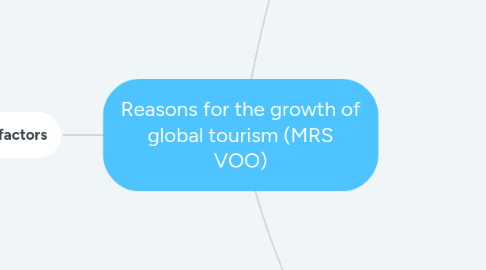
1. (3) Destination factors
1.1. (i) Attractions
1.1.1. An attraction is a feature or quality that makes a place interesting or enjoyable. The attraction is often promoted and enhanced by the tourism industry to attract even more tourists. The governments, tourist authorities and tourism businesses know the value of investing in attractions and they hope that tourists will return repeatedly to spend their tourist dollars. E.g. The Burj Al Arab and The Palm Islands are two top attractions in Dubai, UAE. Attractions are able to entice people to travel more because they add excitement to the travelling experience and offer novelty to the travellers. Therefore, attractions are reasons to the growth of global tourism.
1.2. (ii) Investment in infrastructure and services
1.2.1. Tourist attractions require large investments in infrastructure and services. Infrastructure refers to the transport and communication networks, electrical frameworks and systems for water and waste disposal. Fewer tourists would visit a place if the infrastructure cannot support the positive experience for tourists. E.g. Singapore Changi Airport currently has 5 terminals to serve the needs of all the international visitors so that they can enter the country with convenience. Good infrastructure will attract more tourists to visit the destination because visitors will appreciate the convenience offered by the destination and they will be more confident to explore the destination. Therefore, investment in infrastructure and services is a reason for the growth of global tourism.
1.3. (iii) Access to information
1.3.1. Access to information refers to the ease with which information can be obtained. Tourists are more likely to visit a destination when travel-related information is easy to obtain, both outside and within a destination. E.g. Transport routes and schedules, weather conditions and available accommodation are often available in the language accessible to foreigners. Being able to gain important information like these makes the travel planning easier and adds confidence to the travelers when they are at the destination. Therefore, access to information is a reason for the growth of global tourism.
2. (1) Developments in technology
2.1. (i) Better and affordable transport
2.1.1. Advancements in technology have led to higher safety, shorter travelling time and cheaper travel. E.g. It only takes about 14 hours to fly from Singapore to London and it would take weeks in the past if gone by sea routes. Also, the rise of budget airlines like Air Asia and Scoot Airlines have brought down the cost of travelling. Travelers are now enticed to travel more because it is less costly to do so and they can now go to various destinations that they could not do so in the past. The shorter travelling times is motivating people to travel because they can reduce the hassle of getting from one destination to another. Therefore, better and affordable transport has resulted in the growth of global tourism.
2.2. (ii) Ease of access to information
2.2.1. Developments in information technology has made information more readily available and accessible. This ease of access to information has helped promote air travel and global tourism as we can now buy air tickets or book accommodation online. We can also easily obtain bus or train schedule on websites. E.g. It is now possible to book hotels at booking.com or hotels.com without having to visit any travel agent. Purchasing of plane tickets can also be done in minutes over the internet. Ease of access to information makes things very fast and convenient for travelers planning their tours and it encourages them to want to travel more often and to more places. Therefore, the ease of access to information has resulted in the growth of global tourism.
3. (2) Demand factors
3.1. (i) Disposable income
3.1.1. Disposable income is the amount of income left to an individual after taxes have been paid. Disposable income has been increasing globally because of rapid economic growth. E.g. Countries like China and India have experienced a significant growth in income and many of them are earning more than before. The increase in disposable income encourages people to travel more often and to more destinations because travelers now can afford to do so and they want to spend the money to buy travelling experiences. Therefore, disposable income is a reason for the growth of global tourism.
3.2. (ii) Leisure time
3.2.1. Leisure time is the time when people are free from work responsibilities and commitments. For the middle income and high income groups, leisure time is actually increasing due to more paid leave given as part of the employment package. E.g. In Australia, many employees can exchange paid overtime work for leave. This increases their chances of taking longer weekend breaks. The increase in leisure time entices people to travel more because they have the opportunity to spare to go to more places more frequently. Travelling is a way to keep their off-work time meaningfully occupied. Therefore, leisure time is a reason for the growth of global tourism.
3.3. (iii) Changing lifestyle
3.3.1. Changing lifestyle refers to the amendments in the way people live throughout their lifetime and from generation to generation. The pace of life today is much faster and many people are spending longer hours at work. Travelling becomes a way for people to relax and take a break from their fast-paced lifestyles at work. Due to advances in medical science, people are also living longer than before. Travelling becomes a way to actively engage the individuals during their silver years. E.g. Elder visitors may choose to do site-seeing or visit hot springs or join cruises to spend their time actively during their retirement years. Therefore, changing lifestyle is one reason for the growth of global tourism.
